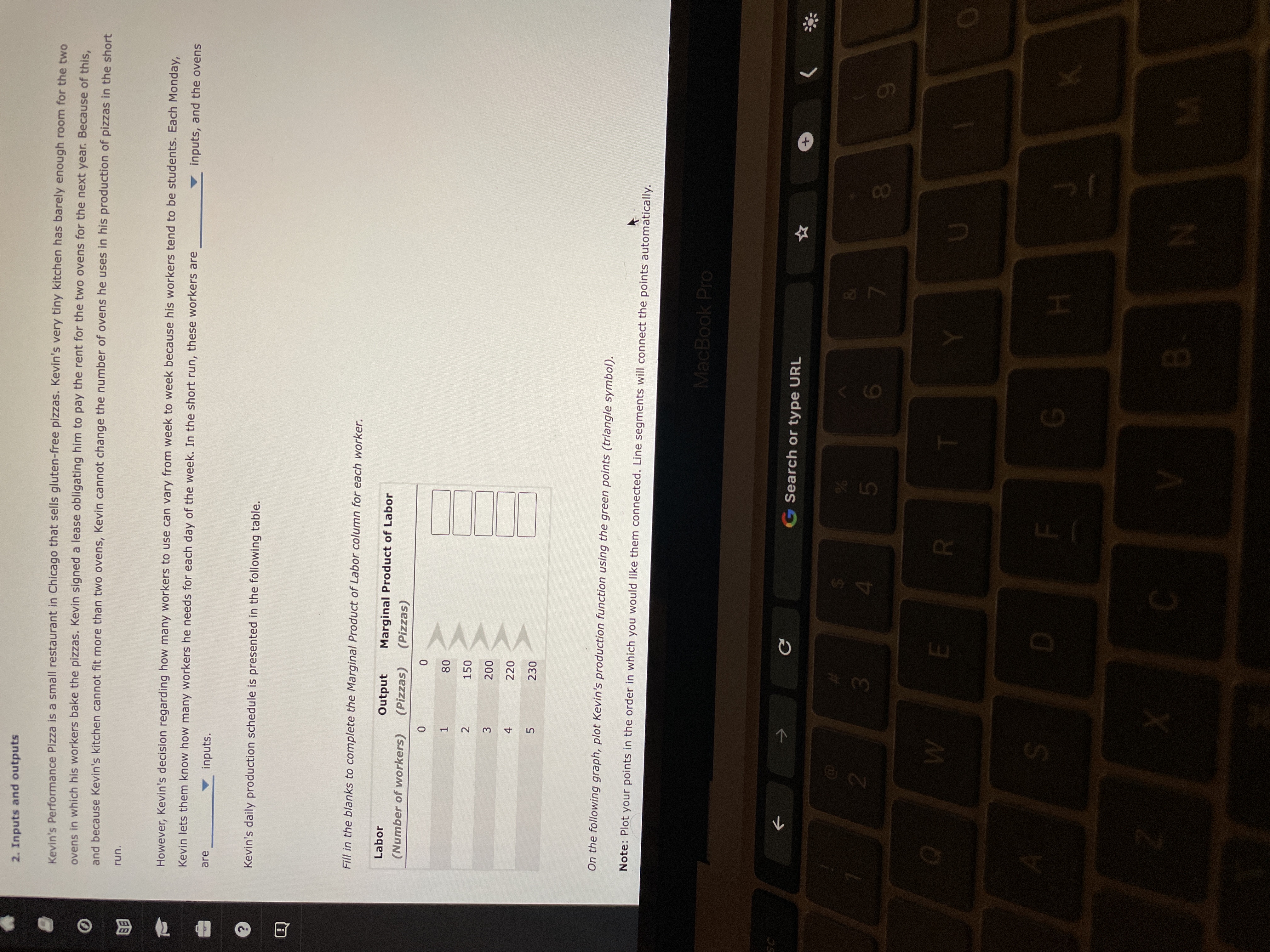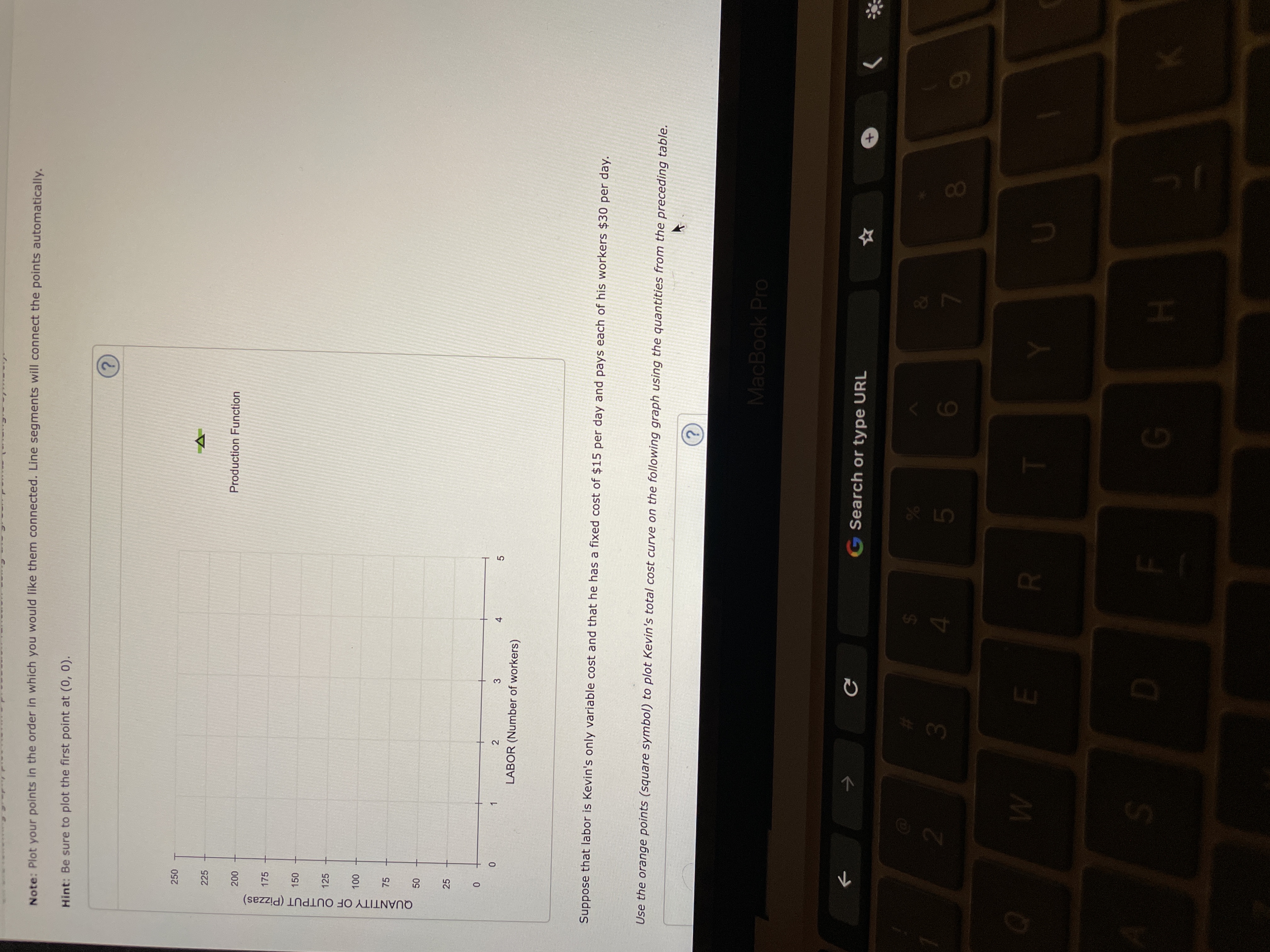
Essentials of Economics (MindTap Course List)
8th Edition
ISBN: 9781337091992
Author: N. Gregory Mankiw
Publisher: Cengage Learning
expand_more
expand_more
format_list_bulleted
Question

Transcribed Image Text:2. Inputs and outputs
Kevin's Performance Pizza is a small restaurant in Chicago that sells gluten-free pizzas. Kevin's very tiny kitchen has barely enough room for the two
ovens in which his workers bake the pizzas. Kevin signed a lease obligating him to pay the rent for the two ovens for the next year. Because of this,
and because Kevin's kitchen cannot fit more than two ovens, Kevin cannot change the number of ovens he uses in his production of pizzas in the short
"un.
因
However, Kevin's decision regarding how many workers to use can vary from week to week because his workers tend to be students. Each Monday,
Kevin lets them know how many workers he needs for each day of the week. In the short run, these workers are
inputs, and the ovens
are
inputs.
Kevin's daily production schedule is presented in the following table.
Fill in the blanks to complete the Marginal Product of Labor column for each worker.
Labor
Output
Marginal Product of Labor
(Number of workers)
(Pizzas)
(Pizzas)
1.
150
2.
3.
220
230
On the following graph, plot Kevin's production function using the green points (triangle symbol).
Note: Plot your points in the order in which you would like them connected. Line segments will connect the points automatically.
MacBook Pro
G Search or type URL
->
3.
4.
081
S.
H.
B.
N

Transcribed Image Text:十
5
F.
25
QUANTITY OF OUTPUT (Pizzas)
Note: Plot your points in the order in which you would like them connected. Line segments will connect the points automatically.
Hint: Be sure to plot the first point at (0, 0).
250
225
Production Function
175
150
125
00 0
75
3
4.
LABOR (Number of workers)
Suppose that labor is Kevin's only variable cost and that he has a fixed cost of $15 per day and pays each of his workers $30 per day.
Use the orange points (square symbol) to plot Kevin's total cost curve on the following graph using the quantities from the preceding table.
MacBook Pro
->
Search or type URL
&
3.
9.
00
6
Expert Solution
This question has been solved!
Explore an expertly crafted, step-by-step solution for a thorough understanding of key concepts.
This is a popular solution
Trending nowThis is a popular solution!
Step by stepSolved in 3 steps with 2 images

Knowledge Booster
Learn more about
Need a deep-dive on the concept behind this application? Look no further. Learn more about this topic, economics and related others by exploring similar questions and additional content below.Similar questions
- Do you think that the taxicab industry in large cities would be subject to significant economies of scale? Why or why not?arrow_forwardWhat is the difference between a fixed input and a variable input?arrow_forwardWould you consider an interest payment on a loan to a film an explicit or implicit cost?arrow_forward
- What is a production function?arrow_forwardWhat is the difference between economies of scale, constant returns to scale, and diseconomies of scale?arrow_forwardA firm had sales revenue of 1 million last year. It spent 600,000 on labor, 150,000 on capital and 200,000 on materials. What was the firms accounting profit?arrow_forward
- Compute the average total cost, average variable cost, and marginal cost of producing 50 and 72 haircuts. Draw the graph of line three curves between 60 and 72 haircuts.arrow_forwardHow do we calculate each of the following: marginal cost, average total cost, and average variable cost?arrow_forwardHow does fixed cost affect marginal cost? Why is this relationship important?arrow_forward
- Return to Figure 7.7. What is the marginal gain in output from increasing the number of batters from 4 to 5 and from 5 to 6? Does it continue the pattern of diminishing marginal returns? Figure 7.7 How output Affects Total costsarrow_forwardHow would an improvement in technology, like the high-efficiency gas turbines or Pirelli tire plant, affect me lung-nm average cost curve of a firm? Can you draw the old curve and the new one on the same axes? How might such an improvement affect other firms in the industry?arrow_forwardBased on your answers to the WipeOut Ski Company in Exercise 7.3, now imagine a situation where the firm produces a quantity of 5 units that it sells for a price of 25 each. What will be the companys profits or losses? How can you tell at a glance whether the company is making or losing money at this price by looking at average cost? At the given quantity and price, is the marginal unit produced adding to profits?arrow_forward
arrow_back_ios
SEE MORE QUESTIONS
arrow_forward_ios
Recommended textbooks for you
 Essentials of Economics (MindTap Course List)EconomicsISBN:9781337091992Author:N. Gregory MankiwPublisher:Cengage Learning
Essentials of Economics (MindTap Course List)EconomicsISBN:9781337091992Author:N. Gregory MankiwPublisher:Cengage Learning Microeconomics: Private and Public Choice (MindTa...EconomicsISBN:9781305506893Author:James D. Gwartney, Richard L. Stroup, Russell S. Sobel, David A. MacphersonPublisher:Cengage Learning
Microeconomics: Private and Public Choice (MindTa...EconomicsISBN:9781305506893Author:James D. Gwartney, Richard L. Stroup, Russell S. Sobel, David A. MacphersonPublisher:Cengage Learning Economics: Private and Public Choice (MindTap Cou...EconomicsISBN:9781305506725Author:James D. Gwartney, Richard L. Stroup, Russell S. Sobel, David A. MacphersonPublisher:Cengage Learning
Economics: Private and Public Choice (MindTap Cou...EconomicsISBN:9781305506725Author:James D. Gwartney, Richard L. Stroup, Russell S. Sobel, David A. MacphersonPublisher:Cengage Learning Principles of Economics 2eEconomicsISBN:9781947172364Author:Steven A. Greenlaw; David ShapiroPublisher:OpenStax
Principles of Economics 2eEconomicsISBN:9781947172364Author:Steven A. Greenlaw; David ShapiroPublisher:OpenStax
 Microeconomics: Principles & PolicyEconomicsISBN:9781337794992Author:William J. Baumol, Alan S. Blinder, John L. SolowPublisher:Cengage Learning
Microeconomics: Principles & PolicyEconomicsISBN:9781337794992Author:William J. Baumol, Alan S. Blinder, John L. SolowPublisher:Cengage Learning

Essentials of Economics (MindTap Course List)
Economics
ISBN:9781337091992
Author:N. Gregory Mankiw
Publisher:Cengage Learning

Microeconomics: Private and Public Choice (MindTa...
Economics
ISBN:9781305506893
Author:James D. Gwartney, Richard L. Stroup, Russell S. Sobel, David A. Macpherson
Publisher:Cengage Learning

Economics: Private and Public Choice (MindTap Cou...
Economics
ISBN:9781305506725
Author:James D. Gwartney, Richard L. Stroup, Russell S. Sobel, David A. Macpherson
Publisher:Cengage Learning

Principles of Economics 2e
Economics
ISBN:9781947172364
Author:Steven A. Greenlaw; David Shapiro
Publisher:OpenStax


Microeconomics: Principles & Policy
Economics
ISBN:9781337794992
Author:William J. Baumol, Alan S. Blinder, John L. Solow
Publisher:Cengage Learning